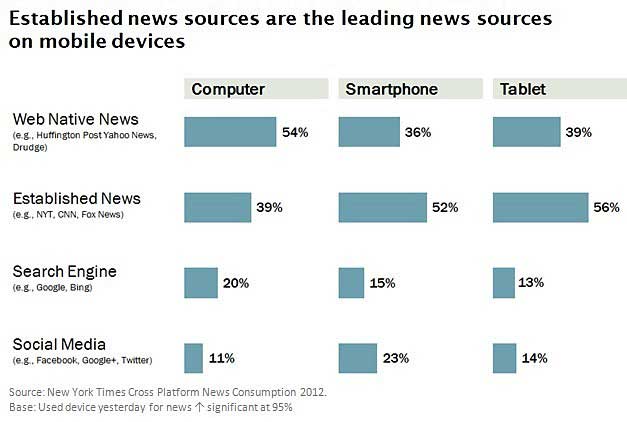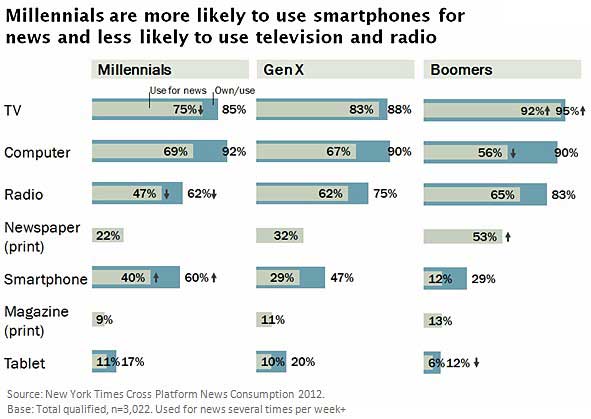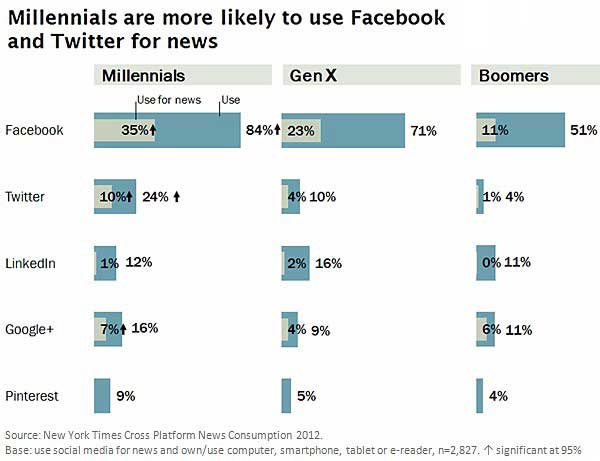Most digital news consumers find news information from Web-native sources such as The Huffington Post and Yahoo, but they rely on more traditional news outlets such as the New York Times and CNN for breaking news stories and for news consumed via mobile devices, according to a report by The New York Times's Customer Insight Group.
News consumers are also loyal to their favorite news brands acoss multiple platforms, the report found.
Despite the multitude of options available to digital news consumers, more than two-thirds (67%) say they are loyal to the same news brands across various digital platforms.
Moreover, mobile news consumers are even more loyal: 75% of digital consumers who access news via smartphone and tablet say they are loyal to the same brands across various platforms, compared with 64% of those who consume news via PC only.
Below, additional findings from The New York Times study of cross-platform news consumption, based on a poll of 3,022 American adults, conducted by Knowledge Networks (a company recently acquired by GfK Custom Research). Among the total sample, 85% qualified as "news consumers," defined in the study as adults who access world news, national news, or local news a few times a week or more from both digital and non-digital sources.
Digital News Consumers
More than one-half (53%) of digital news consumers say they get news information from Web-native sources, while 43% rely on more "established" news sources.

Nearly one in five (19%) digital news consumers say they get news information from search engines, while 15% use social-media sources.
Go-To Sources for Breaking News
The Web has become a key way for media outlets––including traditional ones––to break news more quickly.
Even so, most (50%) news consumers learn about breaking news via television, though 17% learn about such stories via the Web.
However, regardless of which source people use to learn about breaking news, 51% head to a secondary news platform to learn more about the story. If online, 60% of those news consumers turn to traditional news outlets via the Web, 13% turn to Web-native news sites, 12% use search engines, and 6% use social media channels.
Established Brands Leading in News via Mobile
Traditional outlets also have an edge over Web-native news sources among people who consume news via mobile devices: 52% of those who consume news via smartphone and 56% of those who consume news via tablet turn to established news sources for news, compared with 39% of those who consume news via PC.

Similarly, among those who consume news via computer, Web-native sites are the top destination (54%), followed by established news sources (39%).
Young People Consume More Mobile News
Among all generations, TVs and computers are the top channel for news consumption.
However, Millennials (those now age 18-34) are more likely than Gen-X adults (age 35-44) and Boomers (age 45-54) to both own a smartphone and consume news via mobile channels, but they're less likely to consume news via TV, print newspapers, and radio.
For example, some 40% Millennials access news via mobile device, compared with 29% of Gen-X adults and 12% of Boomers.

Among Millennials, the proportion of print newspaper readers (22%) is smaller than the proportion of those who consume news via smartphone (40%).
Among Gen-X adults, the use of those two channels is nearly equal (32% vs. 29%), whereas among Boomers, print newspapers are still very influential (53%).
Top Social Media Outlets
Given Facebook's huge user base (with 84% penetration among Millennials, 71% among Gen-X adults, and 51% among Boomers), the social network attracts more people for news consumption than any other popular social channel.
Millennials particularly turn to Facebook for news: 35% say they use the site as a source for news, compared with 23% of Gen-X adults and 11% of Boomers who say the same:

Social media is also more popular as a news source among owners of mobile devices: 30% of news consumers who use social media for news and own a smartphone or tablet say they find their news via Facebook, 8% do so via Twitter, and 5% so via Google+
Methods for Sharing News
Overall, 54% of news consumers share news content several times a week. Among those 54%, word of mouth (WOM) and email the most popular methods for sharing such content, though levels across both channels vary somewhat by age:
- WOM: 66% of Millennials, 66% of Gen-X adults, and 74% of Boomers share news most by mentioning it to someone else.
- Email: 34% of Millennials, 39% of Gen-X adults, and 32% of Boomers share news most via email.
Millennials are most lilkey to post news links on various websites: 35% do, compared with 19% of Gen-X adults and 9% of Boomers.
Meanwhile, 20% of Boomers say they still tear out new articles from print media to share with others.
About the data: Findings are based on an online survey of 3,022 US residents age 18-65, weighted to match the general population, conducted by Knowledge Networks in the second quarter of 2012. Some 85% of the respondents qualified as "news consumers" who access some kind of news from digital and non-digital sources at least a few times a week.




